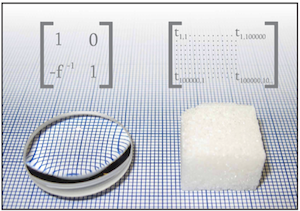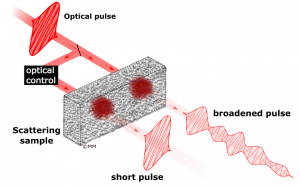TRANSMISSION MATRIX
Publications
- S. M. Popoff, G. Lerosey, R. Carminati, M. Fink, A. C. Boccara, S. Gigan, “Measuring the Transmission Matrix in Optics : An Approach to the Study and Control of Light Propagation in Disordered Media”, Phys. Rev. Lett. 104, 100601 (2010) PRL ARXIV
- S. Popoff, G. Lerosey, M. Fink, A.C. Boccara, S. Gigan, “Image Transmission Through an Opaque Material” , Nature Communications 1:81 doi: 0.1038/ncomms1078 (2010) NCOMMS ARXIV
Transmission matrix focusing and imaging
 A random medium, such as a paint layer for instance, scatters light in a very complex way, but remains a linear system. We have shown that it was possible to measure the transmission matrix of a complex medium, describing light propagation from one side to the other. Using this information and a spatial light modulator, we have shown that it was possible to focus light, and even to image through an opaque medium. We explore how the transmission matrix can be measured in the spectral domain, and how it can be measured fast enough to use in biological systems.
A random medium, such as a paint layer for instance, scatters light in a very complex way, but remains a linear system. We have shown that it was possible to measure the transmission matrix of a complex medium, describing light propagation from one side to the other. Using this information and a spatial light modulator, we have shown that it was possible to focus light, and even to image through an opaque medium. We explore how the transmission matrix can be measured in the spectral domain, and how it can be measured fast enough to use in biological systems.
Spatiotemporal control of an ultrashort pulse
When an ultrashort pulse of light illuminates a multiple scattering sample, such as a paint layer, the output light suffers both spatial and spectral mixing. Spatially, the output intensity is a multiple interference pattern also known as speckle. In the spectral domain, each wavelength of the input pulse will experience a different interference figure because of the scattering. The exact same vision in the temporal domain leads to a broadened pulse, with an average characteristic time much longer than the time-width of the input pulse.
We have developed a transmission matrix approach to coherently control either every wavelength of the output pulse (Multispectral Transmission Matrix) or every arrival time of the output pulse (Time Resolved Transmission Matrix). Using this information in addition with a unique spatial light modulator, we have notably shown a retrieval of the ultrashort pulse after propagation through a thick scattering medium, as well as a control of its temporal behavior in an arbitrary spatial position outside the sample. These approaches could lead to enhance non-linear phenoma or to probe light-matter interactions in highly disordered systems.
Publication(s)
-
A. Boniface, I. Gusachenko, K. Dholakia, S. Gigan, Rapid broadband characterization of scattering medium using hyperspectral imaging, Optica 6, 274 (2019) link
M. Mounaix, D. Andreoli, H. Defienne, G.Volpe, O. Katz, S. Grésillon, and S. Gigan, Spatiotemporal coherent control of light through a multiply scattering medium with the Multi-Spectral Transmission Matrix, Phys. Rev. Lett. 116, 253901 (2016) link
- M. Mounaix, H. Defienne, S. Gigan, Deterministic light focusing in space and time through multiple scattering media with a Time-Resolved Transmission Matrix approach, Phys. Rev. A 94, 041802 (2016) link (rapid communication)
- D. Andreoli, G. Volpe, S. Popoff, O. Katz, S. Grésillon, Gigan, Deterministic control of broadband light through a multiply scattering medium via the multispectral transmission matrix, Scientific Reports 5, 10347 (2015) link

